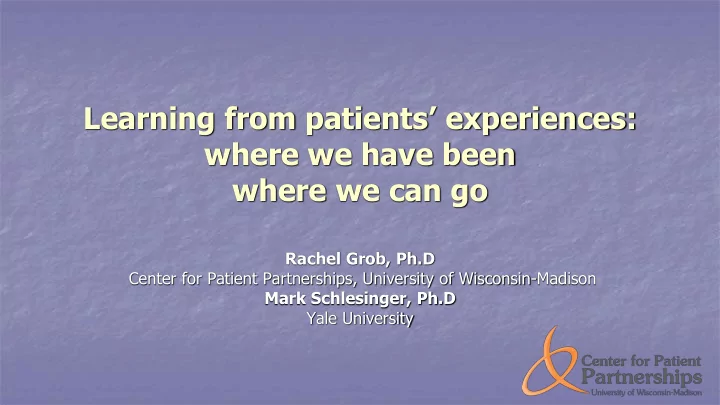

Learning from patients’ experiences: where we have been where we can go Rachel Grob, Ph.D Center for Patient Partnerships, University of Wisconsin-Madison Mark Schlesinger, Ph.D Yale University
Infusing Patients’ Voices... Better Health Outcomes Patient Advocacy Professional Education Service Co-design Research/Policy Advocacy
Definition of rigor in the move from anecdote to science: • Sampling • Elicitation • Interpretation
Eliciting Patient Narratives in American Medicine Applying Rigorous Qualitative Methods to Large-Scale Collection of Patient Experience
Eliciting Patient Narratives at Large-Scale Laying the Groundwork Developing criteria for rigor Several rounds of elicitations Matched interviews for validation
Eliciting Patient Narratives at Large-Scale Laying the Groundwork Developing criteria for rigor 4 criteria Several rounds of elicitations Matched interviews for validation
Criteria for Rigorous Elicitation Complete : provide a full picture of the experiences that matter to the patient describing them Balance d : accurately reflect both positive and negative aspects of the patient's experiences Meaningful : convey a story that is coherent to other patients and allows them to assess its relevance to their own care Representative : Capture experiences from patients across a range of health status and socio-demographics
Eliciting Patient Narratives at Large-Scale Laying the Foundation Developing criteria for rigor Several rounds of elicitations 758 cases Matched interviews for validation
Eliciting Patient Narratives at Large-Scale Laying the Foundation Developing criteria for rigor Several rounds of elicitations 758 cases Matched interviews for validation 100 cases
Testing (and Refining ) the Protocol COMPLETENESS of Reported Experiences By Elicitation Round and Mode 100% 90% 80% 70% 60% Full Sample 50% Phone Sample 40% 30% Web Sample 20% 10% 0% Overall Match: Round 1 Overall Match: Round 2
Eliciting Patient Narratives at Large-Scale Laying the Foundation Developing criteria for rigor Several rounds of elicitations Matched interviews for validation Evaluation Complete
Completeness of Elicitation
Eliciting Patient Narratives at Large-Scale Laying the Foundation Developing criteria for rigor Several rounds of elicitations Matched interviews for validation Evaluation Balanced
Balance of Elicitation
Eliciting Patient Narratives at Large-Scale Laying the Foundation Developing criteria for rigor Several rounds of elicitations Matched interviews for validation Evaluation Meaningful
Coherence of Elicitation
Eliciting Patient Narratives at Large-Scale Laying the Foundation Developing criteria for rigor Several rounds of elicitations Matched interviews for validation Evaluation Representative
Representativeness of Elicitation
Eliciting Patient Narratives at Large-Scale Laying the Foundation Evaluation Dissemination Pilot-testing: CA and MA Initial Implementation: MA
A Database of Patient Experience: Eliciting Rich Narratives about Health and Health Care
Why DIPEx? Identify questions and problems that matter to patients Provide support and information to patients and caregivers Promote balanced encounter between patients and health professionals Be a learning resource for medical students, doctors, nurses and other health professionals Inform policy
DIPEx methodology Aim is to represent the broadest possible range of perspectives, using rigorous qualitative research methods For each health condition (or module), researchers conduct 40 - 50 interviews, among patients from different backgrounds, recruited through a range of avenues (maximum variation) Interviews continue until no new ideas or experiences are voiced (saturation)
DIPEx methodology Transcripts coded by theme, with focus on both common and divergent experiences Researchers produce ~ 35 summaries in lay language, illustrated with video, audio, or written interviews clips (roughly 350 clips per module) Modules disseminated via publicly-available website (e.g. www.healthtalk.org ); data available for secondary analysis and use (with permission)
DIPEx International www.dipexinternational.com
Partnership between University of Wisconsin, Johns Hopkins University, Oregon Health & Science University, and Yale University.
Health Experiences Research Network (HERN) Steering Committee Launched in in 2014 Rachel Grob, MA, PhD Chair Erika Cottrell, PhD, MPP Kay Dickersin, PhD Mark Helfand, MD, MPH Kate Smith, PhD, MA Nancy Pandhi, MD, PhD Mark Schlesinger, PhD
US Health Experiences Modules Two funded modules Depression in young adults (UW-Madison) Veterans with traumatic brain injury (VA/OHSU) Proposed modules under review Gulf War Illness (VA) Pediatric cancer (NIH CTSA) Adults with congenital heart disease (NIH CTSA) Low back pain (Donaghue Foundation)
HERN’s commitment is to: Listen to patients to capture a wide range of experiences and priorities Empower patients by giving voice to their story and choices about sharing their data Bring in voices that wouldn’t be heard through other engagement activities Move from voice to voices – synthesizing themes and disseminating to broad audiences – not just peer-reviewed literature
US Module: Young Adults with Depression
US Module: Young Adults with Depression Study Team Rachel Grob, MA, PhD Nancy Pandhi, MD, MPH, PhD Meg Wise, PhD Mark Schlesinger, PhD Natalie Wietfeldt, BA Cecie Culp, MPA Funder Acknowledgements University of Wisconsin School of Medicine and Public Health Wisconsin Partnership Program University of Wisconsin Medical Foundation University of Wisconsin Institute for Clinical and Translational Research funded by a Clinical and Translational Science Award (CTSA) program, through the NIH National Center for Advancing Translational Sciences (NCATS), grant UL1TR000427 The Center for Patient Partnerships University of Wisconsin Department of Family Medicine and Community Health University of Wisconsin-Madison Health Innovation Program
Young adulthood: A critical time of change
Our Recruitment Flyer
Where we’ve Interviewed
Live Depression Module www.healthexperiencesusa.org
Empowering patients by giving voice to their story and control over how it is shared Ongoing communication to review and approve materials Feeling seen Redacting materials Ongoing engagement: e-mail Advisory Group Sampling Topic Summaries Bios
Bringing in voices that wouldn’t be heard through other engagement activities For example, engaging quiet and diverse voices “… many of the most important institutions of contemporary life are designed for those who enjoy group projects and high levels of stimulation…”
… and Helping Every Voice be Heard
From Voice ….
…..to Voices
Your Questions?
Recommend
More recommend